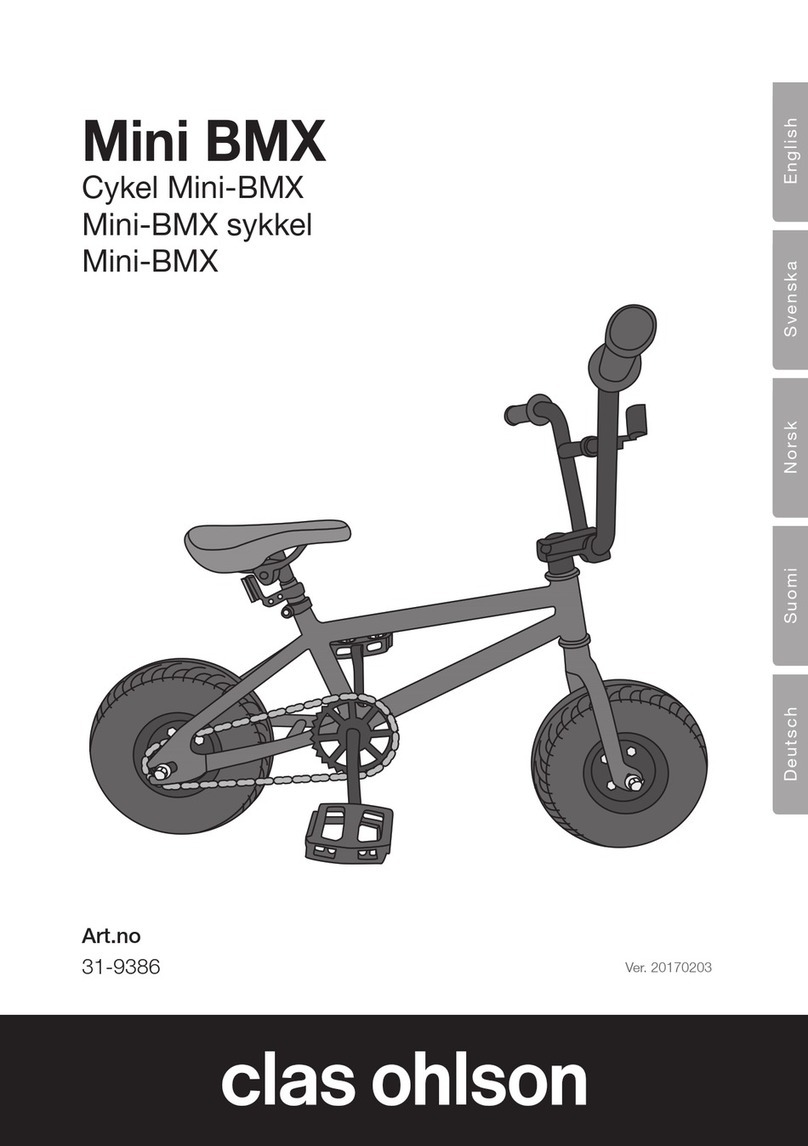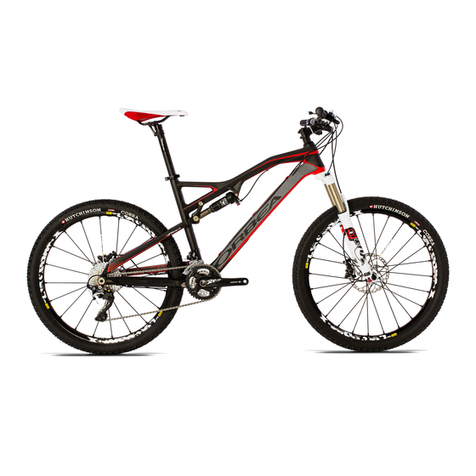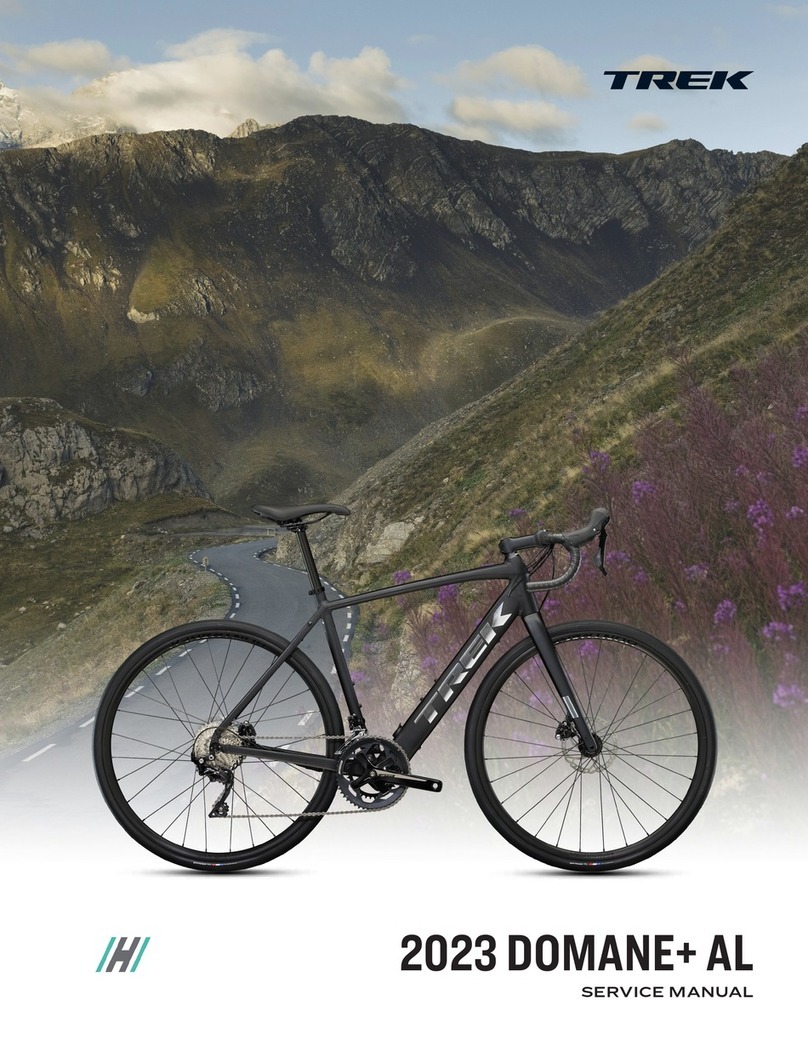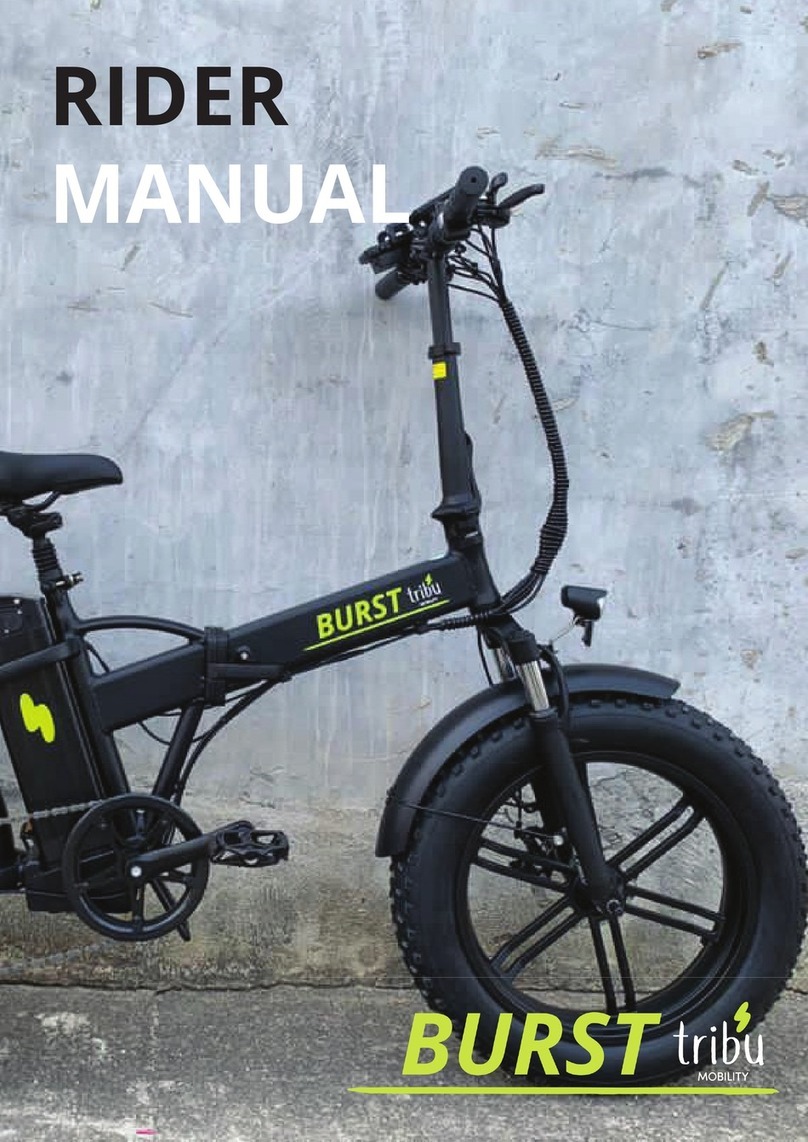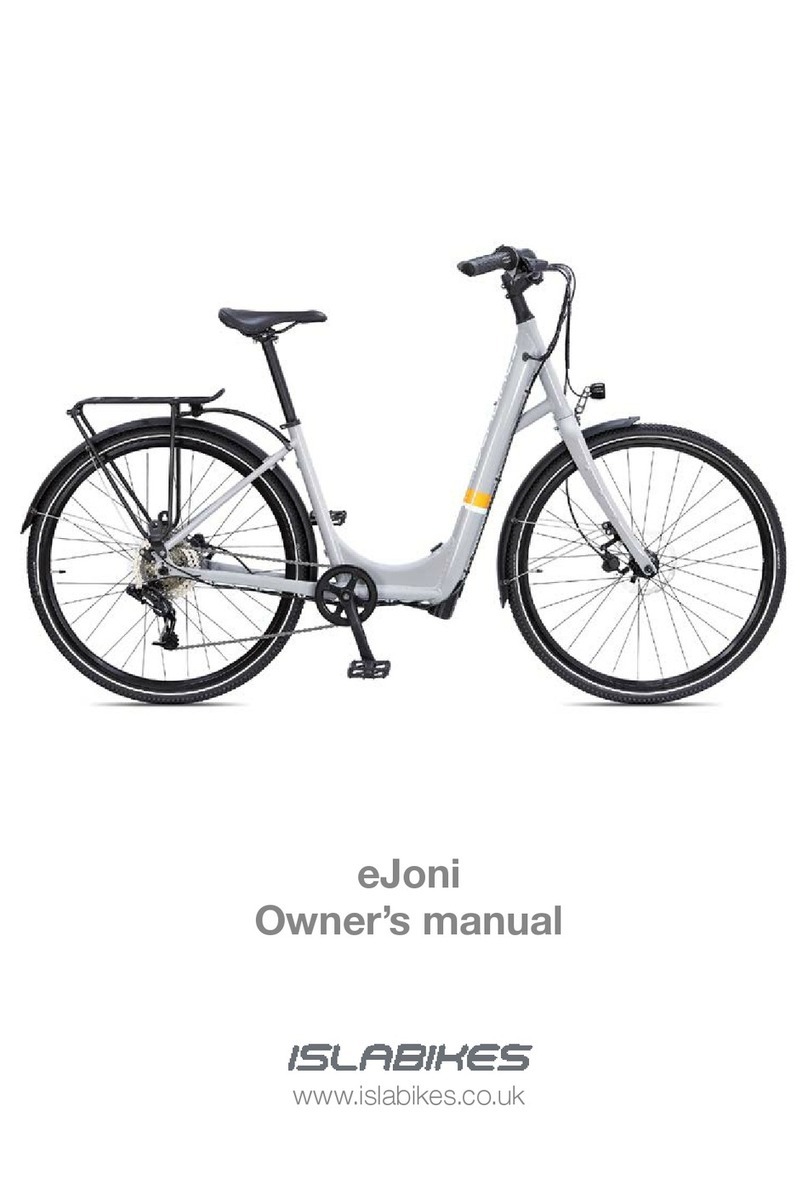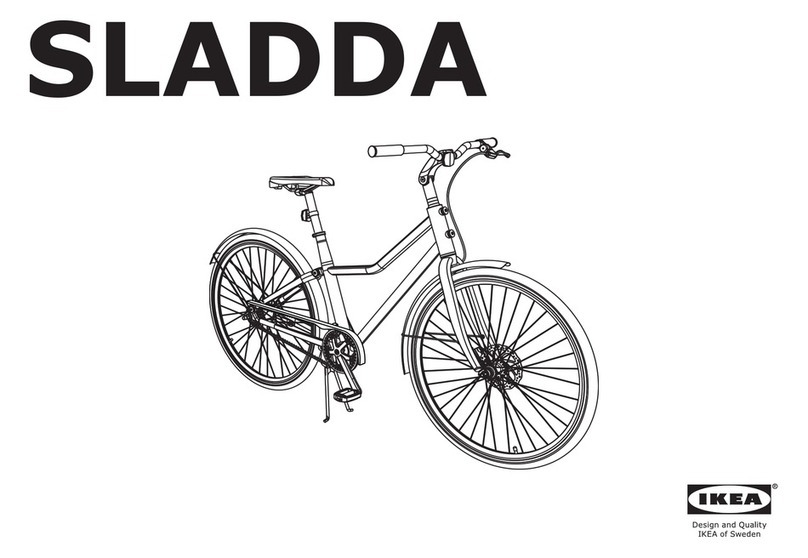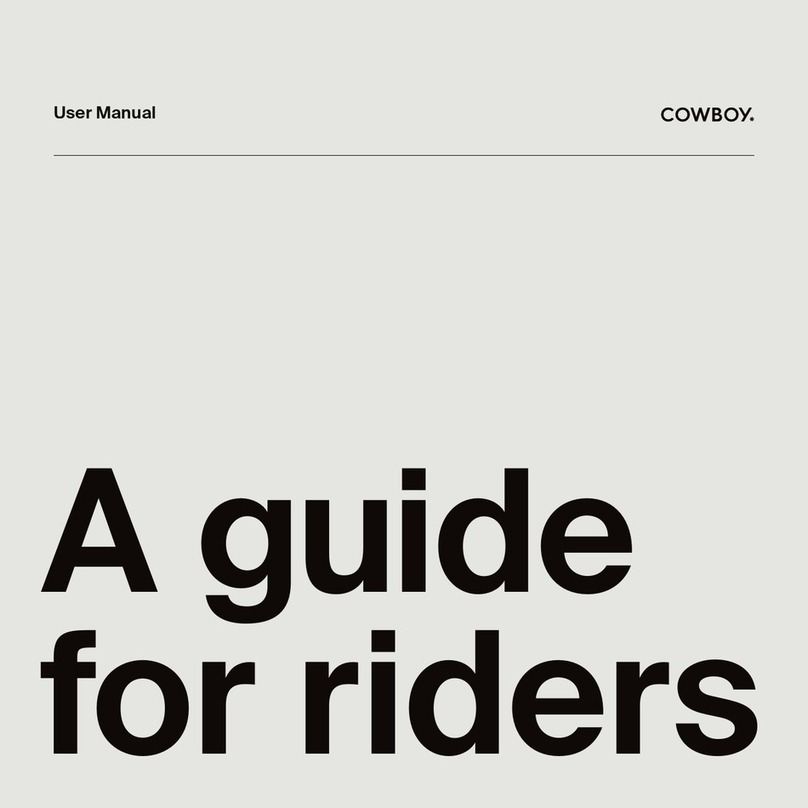Clas Ohlson OYAMA SIGNATURE Series User manual

SIGNATURE COLLECTION
LIMITED EDITION
″FOLDINGBIKE
ART.NO. MODEL: OYAMABICYCLES
ART.NO. MODEL: OYAMABICYCLES

2
English
20″Folding bike
Art.no 18-1478 Model 14380-Oyama Bicycles
31-2001 14380-Oyama Bicycles
Please read theentire instruction manual before using theproduct and then save it for future reference.
We reserve theright for any errors in text or images and any necessary changes made to technicaldata.
Ifyou have any questions concerning technical problems please contact our Customer Services.
Contents
1. Safety..........................................................................................................3
2. Product description................................................................................4
3. Folding out and folding up thebicycle...............................................6
3.1 Folding out thebicycle.................................................................................................................. 6
3.2 Folding up thebicycle................................................................................................................... 7
3.3 Before initialuse............................................................................................................................8
3.4 Checklist before every cyclingtrip...........................................................................................8
4. Settings......................................................................................................9
4.1 Handlebars .......................................................................................................................................9
4.2 Saddle............................................................................................................................................. 10
5. Checking/adjusting thebrakes ............................................................11
5.1 Front and rear rim brakes .............................................................................................................11
5.2 Coasterbrake .................................................................................................................................11
5.3 Checking for rimwear .................................................................................................................12
6. Checking/adjusting thegears..............................................................12
7. Checking/adjusting chain tension.......................................................12
8. Attaching/removing thewheels .........................................................13
8.1 Wheel alignment............................................................................................................................14
9. Careand maintenance..........................................................................14
9.1 Winter storage................................................................................................................................14
10. Disposal...................................................................................................14
11. Specifications .........................................................................................15

3
English
1. Safety
Warning
• Never brake hard using thecoaster brake in slippery conditions,e.g. on gravel, ice, snow or wet
tarmac.
• For steep hills several braking methods should be combined, otherwise using thecoaster brake
may cause therear wheel to overheat.
• Always brake using therear brakes first before aempting to use thefront brakes. Thisespecially
applies if road surfaces are slippery.
• This bicycle is not designed to be used with bicycle child seats or similar.
• As with all mechanical components, thebicycle is subject to wear and high stressloads. Different
materials and components may react to wear or stress fatigue in differentways. Allcomponents
have acertain lifespan and if thelife of acomponent has been exceeded, it may suddenly fail
causing possible injury to theuser. Anyform of cracks, scratches or changes of colouring in
highly stressed areas indicate that thelife of thecomponent has been reached and it should
bereplaced.
• Max total weight 119 kg (bicycle + cyclist+ luggage).
• Max luggage carrierload: 15kg.
• Max cyclist weight: 90kg.
Important
• Thebicycle is designed to be ridden on normal roads and not for terrain or competitiveuse.
Anyform of use other than that described in this instruction manual can lead to aserious risk for
personal injury or damage to thebicycle itself.
• Tighten all nuts, bolts and screws but do not overtighten.
• Adjust thebicycle so that it fitsyou. Thereare quick releases for thehandlebars, stem and seat
post, which makes adjustments easy to fit different bodysizes.
• Always conduct asafety check beforeusing.
• Always use aproperly adjusted and fied helmet.
• Always keep both hands on thehandlebars.
• Wear clothing that makes you visible to your fellow roadusers.
• Thebicycle must be equipped with wheel reflectors, both front and back, and pedal reflectors.
Makesure that all reflectors are clean and visible.
• When cycling in thedark, make sure that you have properly functioning lights, both front andrear.
• Remember that rules and regulations for bicycles will differ from country to country. Thismay
include regulation regarding front, rear and side reflectors along with front and rear lights.
Familiarise yourself with therules and regulations that apply in your country.
• Always cycle in thesame direction as trafficflow. Nevercycle against traffic.
• Always follow thelocal traffic regulations.
• Show consideration in traffic. Donot cycle close to pedestrians, horse riders or thedisabled.
• Never wear loose fiing clothing or similar apparel that can be caught in thebicycle chain or wheels.

4
English
6
8
7
3
54
12 9
10
11
12
14
14
15
16 17
18 14
19
20
21 22
28
30
31 33
34
35
37
38
39
40
32
29
26 23
27 24 25 36
13
14
Tightening
saddle 10 Nm
Tightening front
wheel 30–35 Nm Tightening rear
wheel 35–40 Nm
2. Product description

5
English
1. Handlebars
2. Bicyclebell
3. Gear shier
4. Gear indicator
5. Gear shier wire adjustment barrel
6. Brake lever (one on each side of thehandlebar)
7. Adjustment screw for regulating thedistance of thebrake from thehandlebars
8. Brake wire adjustment barrel
9. Quick-connect for locking/adjusting theangle of thehandlebars
10. Brake wires (x 3)
11. Stem
12. Quick-connect for locking/adjusting theheight of thestem
13. Handlebar lock mechanism
14. Reflectors (front, rear, wheels and pedals)
15. Front rim brakes
16. Spring tension adjustmentscrew
17. Brakepad
18. Frontfork
19. Frontwheel
20. Tyre
21. Frame
22. Frame lock mechanism
23. Crankarm
24. Pedal
25. Chain
26. Chainguard
27. Stand
28. Seatpost
29. Saddle
30. Saddleclamp
31. Quick-connect for adjusting/locking theheight of theseatpost
32. Rear rim brakes
33. Bicyclerack
34. Rearwheel
35. Rear coaster brakehub
36. Rear coaster brakearm
37. Gear paddle
38. Gear paddle lockingscrew
39. Gear paddle adjustment barrel
40. Gear adjustment window

6
English
13
22
3. Folding out and folding up
thebicycle
Thebicycle comes fully assembled but in foldedform.
3.1 Folding out thebicycle
1. Fold thehinges on theframe so that
theends of theframe legsmeet.
3. Extend thehandlebars in thestem.
2. Press thelever on theframe lock
mechanism towards theframe until thelock
clicks intoplace.
4. Press thelever on thehandlebar lock
mechanism towards thehandlebar until
thelatch clicks intoplace.

7
English
5. Open thepedals out so they click
securely intoplace.
3.2 Folding up thebicycle
1. Push in thepedals. 2. Fold up thepedals.
3. Press thelatch on thehandlebar lock
mechanism to theside and open up
thelever.
4. Fold down thehandlebar.

8
English
3.3 Before initialuse
Information
Refer to theseings and adjustments in the4. Seings section.
General
• Read theinstruction manual and familiarise yourself with thebicycle so you understand how it
works in all situations.
• Focus in particular on how to operate thebrakes and steering.
• Test ride thebicycle on aflat surface in anarea free of traffic to familiarise yourself with
thebicycle. Makesure you know how to safely mount and dismount thebicycle. Makesure that
you know how to brake, steer and changegears.
• Adjust theheight and angle of thesaddle and handlebars according to yourshape.
• Become familiar with how thebrakes operate and identify which brake handle operates thefront
rim brake and which operates therear rimbrake.
Important
• You operate thefront rim brake with thebrake mechanism on theleside.
• You operate therear rim brake with thebrake mechanism on therightside.
• This bicycle is also equipped with acoaster brake, which is activated when either of thepedals
are pushed in abackwards direction.
3.4 Checklist before every cyclingtrip
• Check that theframe (21), front fork (18) and any stressed areas show no signs of cracks, scratches,
marks, changes of colour or make no strange sounds.
• Check thebraking performance of thevarious braking methods in anarea where there is no
traffic or other obstacles.
• Check that thesaddle (29) is aligned with theframe (21).
• Check that thelock levers for folding theframe (22), handlebar assembly (13) and angle of
thehandlebars are securely locked and that their catcheshold.
5. Press thelatch on theframe lock
mechanism to theside and open up
thelever.
6. Fold thehinges on theframe so that
theends of theframe legs areapart.

9
English
9
12
• Check that thesaddle (29) cannot be twisted to theside or turned up/down. Adjust thesaddle
and tighten thesaddle clamp if necessary (30).
• Check that no brake wires (10) are caught.
• Check that thewheels (19 and 34) are on tight by liing thebicycle so that thewheel leaves
theground and slap theupper side of thewheel with yourhand. Ifthewheel is loose or is loose in
thefork dropouts, thewheel axle nuts must be tightened.
• Check thetyre pressure; see therecommended pressure on thewheel (20)page.
• Check that thewheels are straight,i.e. that therims do not wobble upwards and downwards or
from side to side by liing thebicycle off theground and spinning thewheel.
• Make sure that thereflectors (14) are clean and screwed on tightly.
• Check that any lighting is working (sold separately).
4. Settings
4.1 Handlebars
Adjusting theheight of thehandlebars
1. Loosen thequick connector on thestem by folding out theclip (12).
2. Pull thestem up or push it down to select theright height.
Warning:Themarkings IIIIIIIIIIIIIIIIIII on thestem should not been
seen above thequick connector.
3. Push back theclip to lock thestem intoplace.
4. Check that thestem is fixed by trying to twist it alile while you keep
thefront wheel of thebicycle firmly between yourlegs.
a) If it is possible to twist thestem, loosen thequick connector again
and twist theknurled screw half aturn in aclockwise direction.
Pushtheclip back again to lock thestem intoplace.
b) If you can still twist thestem, repeat step auntil it istight.
Adjusting theangle of thehandlebars
1. Loosen thequick connector on thestem (9) by folding
out theclip.
2. Grab thehandlebars and twist thestem upwards and
downwards to select thedesiredangle.
3. Push back theclip to lock thestem intoplace.
Important
Make sure that all steering components are in proper
working order aer adjustment.

10
English
30
4.2 Saddle
Adjusting height
Thesaddle height should be adjusted so that your foot, with your leg almost completely extended,
can be placed flat onto thepedal at theboom of thepedal stroke. Youshould also be able to touch
theground with your toes if needed.
1. Loosen thequick connector on theseat post (28) by folding out theclip (31).
2. Pull theseat post up or push it down to select theright height on thesaddle.
Warning
• Theseat post is graduated from 1–26 to indicate theseat height.
Neveradjust theseat post outside of these end markings as it
can become loose or touch theground.
• Make sure that themarkings IIIIIIIIIIIIIIIIIII on theseat post
cannot be seen above theseattube.
3. Push back theclip to lock theseat post intoplace.
4. Check that theseat post is firmly aached to theseat tube by trying to twist thesaddle.
a) If it is possible to twist theseat post, loosen thequick connector again and twist theknurled
screw half aturn in aclockwise direction. Pushtheclip back again to lock theseat post intoplace.
b) If you can still twist theseat post, repeat step auntil it istight.
c) If thesaddle twists around theseat post, go to theAdjustinglength and angle section.
Adjusting length andangle
Thesaddle position and angle in horizontal plane can be adjusted on theseatpost. Finding acomfor-
table seat position depends on your personaltaste. Itmay require along bicycle ride for you to find
aposition that is most comfortable foryou.
1. Loosen thesaddle clamp nuts (30) and push thesaddle forwards
and backwards to get thedesired position in ahorizontalplane.
2. Press and pull thefront or rear edge of thesaddle to set
thedesiredangle.
3. Tighten thesaddle clamp nuts to lock thesaddle firmly in place
(to atorque of 10Nm).
Important
Remember to lock all quick-releases and tighten thesaddle clamp
nuts before you start tocycle.

11
English
8
16
5. Checking/adjusting thebrakes
5.1 Front and rear rim brakes
Check that both rims are intact and free from grease oroil.
Regular brake checking procedure: Pullthebrake handles and make sure that thebrake lines are
whole, that both brake pads make contact with therims simultaneously and that thebrake handles
cannot be pulled so far that they touch thehandlebars.
Adjust therim brakes as necessary.
• Adjust thebrake pads (17) to ensure that they are
aligned with therims and do not come into contact with
thetyres during braking.
• Thedistance between thebrake pads and therims
should be about 1–2mm. Adjust this distance using
thebrake wire adjustment barrel (8) at thehandlebars.
• Adjust thebrake position using thespring tension
screws (16) so that each brake pad makes contact with
therims simultaneously.
• Change brake pads when necessary using thesame type
of brake pads as thebike was originally equippedwith.
Brakepads should be positioned (toe-in) angled inwards
with thebrake pad’s leading edges approximately 1 mm
from therim. Thebrake pads have spherical washers for
adjustment purposes.
5.2 Coasterbrake
Thecoaster brake cannot be adjusted. Warning: Makesure that thebrake arm (36) is securely
fastened, otherwise it will not function properly. Thiscan cause therear wheel to lock and increase
therisk for personal injury.

12
English
SET
SET
40
Theeffectiveness of your brakes also depends on
thecondition of yourrims. Thesemust be checked regularly
forwear. Goodrims are animportant safety feature.
Thesides of your rims come under strain during braking and
may eventually develop cracks. Because of this your rims
are equipped with wear indicators. Theseare in theform of
grooves etched onto theside of therims where thebrake
pads make contact.
These grooves must remain visible. Thewheels need to be
replaced once these grooves can no longer beseen.
Warning: Ifworn rims are not replaced, they may cause
thewheels to lock during braking which can greatly increase
therisk for personal injury.
6. Checking/adjusting thegears
Set thegear shier (3) in secondgear.
Make sure thegear indicator is between thewindow’s (40)
indicatorlines. Ifnot; adjust with thebellcrank adjustment
barrel (39) and then tighten thelock nut behind thebarrel
aer adjustment.
7. Checking/adjusting chain tension
Free play from thechain’s midpoint should
not exceed 20mm.
Thechain will be stretched duringuse.
Makesure that chain tension is regularly
checked and adjusted to maintain optimum
chain tension.
5.3 Checking for rimwear

13
English
38
39
37
8. Attaching/removing thewheels
If awheel needs to be removed,e.g. when atyre is flat, remove thebrake wire’s metal guide from its
bracket in order for thetyre to li out freely.
• Front wheel change: Screwin theadjustment barrel
(8) on thehand brake as far as it cango. Pinchthetwo
brake arms together to remove theguide from its
bracket. Spread thebrake armsapart.
• Rear wheel change: Screwin
theadjustment barrel (8) on
thehand brake as far as it
cango. Pinchthetwo brake
arms together to remove
theguide from its bracket.
Remove thebellcrank (37).
Usea10mm
spanner (see fig) and loosen
thebellcrank locking screw
(38) and move thebellcrank
to theside.
Refit all thedisassembled parts in reverseorder. Remember to screw theadjustment barrel (8) on
thehand brake back out again and adjust therear brakes for proper functioning aer mounting
therear wheel, see the6. Checking/adjusting thegears section. Checkwheel alignment,see
the8.1 Wheel alignment section. Ensure that re-assembly was done correctly and check that
thebrakes are functioning properly before riding.

14
English
8.1 Wheel alignment
If you tighten thechain aer replacing therear wheel,
make sure that both thefront and rear wheels are aligned
with each other aer assembly. Checking alignment:
Fromthefront of thebike, point thehandlebars straight
and using your line of sight, check that thefront and rear
tyres lineup. Otherwise use astraight board bued up
against thetyres to check for alignment. Ifthewheels are
out of alignment with each other it will be hard to steer and
control thebike.
Ensure that re-assembly was done correctly and check that
thebrakes are functioning properly before riding.
9. Careand maintenance
• Clean your bicycle regularly. Usewarm water and abrush or sponge for cleaning. Tryto avoid
using apressure washer for cleaning as thewater jets may penetrate theball bearing housing and
shorten thelife of yourbike.
• Regularly check that all screws and nuts are securely tightened. See2. Product description.
• Clean thechain with abrush and dry with acloth.
• It is important that thechain, gears, wires and other moving parts are well lubricated with proper
lubrication.
• Note: Makesure that thechain is correctly tensioned. Freeplay from thechain’s midpoint should
not exceed 20mm.
• Regularly check for brake wear and proper operation.
• Replace thebrake pads whenworn. Ifthebrake pads are not completely worn, adjust thebrake
wire to improve braking performance.
• If your brakes don’t grip properly, it may be that thehandlebar post or handlebars are loose or
that your wheels are warped - leave your bike in for service at any Clas Ohlson Store or call Clas
Ohlson’s Customer Services for assistance.
• Check both front and back lights and that all reflectors are whole andclean.
• Inflate tyres to their recommended pressure as marked on your tyre’s sidewalls.
• Make sure that no sharp stones and similar objects are caught in your tyres and that there is no
other visible damage.
• Store your bicycle in asheltered environment. Thiswill prolong thelife of your bicycle considerably.
9.1 Winter storage
• If you need to store your bicycle for any longer period, such as in winter, it should be stored in
adry frost-free environment.
• Make sure that your tyres are properly inflated.
• Remove any baeries from your lights, otherwise there is arisk that they can leakand
cause damage.
• Make sure to wipe your rims when taking your bike out of storage as these can collect dust and
interfere with theproper functioning of your brakes.
10. Disposal
This product should be disposed of in accordance with local regulations.
If you are unsure how to proceed, contact your local council.

15
English
95 cm
65 cm
37 cm
11. Specifications
Approx weight 14kg
Saddle height Max 99 cm (depending on tilt angle)
Min height approx 72cm
Handlebar height Max 105 cm (depending on tilt angle)
Min height approx 91cm
Approx folded size 95×65×37 cm (w×h×d)
This bicycle meets European safety standard EN14764: 2005.

16
Svenska
Cykel 20″
Art.nr 18-1478 Modell 14380-Oyama Bicycles
31-2001 14380-Oyama Bicycles
Läs igenom hela bruksanvisningen före användning och spara den sedan för framtidabruk.
Vi reserverar oss förev. text- och bildfel samt ändringar av tekniskadata.
Vid tekniska problem eller andra frågor, kontakta vår kundtjänst (se adressuppgier på baksidan).
Innehållsförteckning
1. Säkerhet ....................................................................................................17
2. Produktbeskrivning................................................................................18
3. Montering............................................................................................... 20
3.1 Fälla ut cykeln................................................................................................................................20
3.2 Vika ihop cykeln.............................................................................................................................21
3.3 Innan första cykelturen .............................................................................................................. 22
3.4 Checklista inför varje cykeltur................................................................................................. 22
4. Inställningar............................................................................................23
4.1 Styret ...............................................................................................................................................23
4.2 Sadeln .............................................................................................................................................24
5. Kontrollera/justera bromsarna..........................................................25
5.1 Fälgbromsar fram/bak .................................................................................................................25
5.2 Navbroms.......................................................................................................................................25
5.3 Kontrollera fälgarnas slitage......................................................................................................26
6. Kontrollera/justeraväxel.....................................................................26
7. Kontrollera/justera kedjespänning....................................................26
8. Montering/demontering avhjul.........................................................27
8.1 Hjulinställning ................................................................................................................................28
9. Skötsel och underhåll...........................................................................28
9.1 Vinterförvaring av cykeln............................................................................................................28
10. Avfallshantering...................................................................................28
11. Specifikationer......................................................................................29

17
Svenska
1. Säkerhet
Varning!
• Bromsa aldrig hårt med frambromsen vid halt väglag,t.ex. på is och snö eller på regnvåt asfalt.
• Ikraiga nedförsbackar ska flera bromssystem användas, annars kan navbromsen ibakhjulet
överheas.
• Bromsa alltid först med bakhjulsbromsen innan du bromsar med framhjulsbromsen, dea gäller
speciellt om körbanan ärhal.
• Cykeln är inte avsedd för a användas med barnstol eller liknande.
• Som alla mekaniska komponenter är cykeln utsa för slitage och stora påfrestningar.
Olikamaterial och olika komponenter kan reagera för slitage och materialutmaning på olikasä.
Allakomponenter har enviss livslängd och om livslängden överskrids kan enkomponent plötsligt
sluta fungera och därmed medföra risk för personskada för användaren. Allaformer av sprickor,
repor eller färgändring isärskilt utsaa komponenter kan påvisa a komponentens maximala
livslängd har nås och a den därmed ska bytasut.
• Max totalvikt 119 kg (cykel + cyklist + bagage).
• Maxbelastning pakethållare 15kg.
• Maxvikt cyklist 90kg.
Viktigt
• Cykeln är avsedd för användning på normala vägar, den är inte avsedd för körning iterräng eller
för användning inågon form av tävlingsverksamhet. Användning på annat sä än vad som beskrivs
här kan medföra risk för personskada eller skada på cykeln.
• Dra åt skruvar och murar så a de sier säkert, men dra inte förhårt.
• Ställ in cykeln så a den passardig. Cykeln har snabbjusteringar för styre, styrstam och
sadelstolpe som gör den enkel a anpassa eer olika kroppstyper.
• Gör alltid ensäkerhetskontroll innan användning.
• Använd alltid hjälm, hjälmen ska vara hel och rä justerad.
• Håll alltid båda händerna på styret.
• Tänk på a använda kläder som gör a du syns av övriga trafikanter.
• Cykeln måste vara försedd med reflexer ihjulen, fram och bak samt på pedalerna. Setill a
cykelns reflexer är rena och väl synliga.
• Vid färd imörker måste cykeln ha fungerande belysning både fram ochbak.
• Tänk på a regler och förordningar för cyklar kan vara olika iolika länder, det kan krävas reflexer
framåt, bakåt och åt sidorna samt belysning framåt ochbakåt. Tareda på vad som gäller idiland.
• Åk alltid isamma riktning som den övriga trafiken, åk aldrig mot trafiken.
• Följ alltid gällande trafikregler.
• Visa hänsyn itrafiken, åk inte för nära fotgängare, ryare eller rörelsehindrade.
• Använd inte löst hängande kläder eller liknande som kan fastna ikedjan eller ihjulen när du cyklar.

18
Svenska
6
8
7
3
54
12 9
10
11
12
14
14
15
16 17
18 14
19
20
21 22
28
30
31 33
34
35
37
38
39
40
32
29
26 23
27 24 25 36
13
14
2. Produktbeskrivning
Åtdragningsmoment
sadel 10 Nm
Åtdragningsmoment
framhjul 30–35 Nm
Åtdragningsmoment
bakhjul 35–40 Nm

19
Svenska
1. Styre
2. Ringklocka
3. Växelreglage
4. Växelindikator
5. Justerskruv för växelvajer
6. Bromshandtag (epå varje sida av styret)
7. Justerskruv för bromsreglagets avstånd mot styret
8. Justerskruv för bromsvajer
9. Snabbkoppling för låsning/justering av styrets lutning
10. Vajrar (3st.)
11. Styrstam
12. Snabbkoppling för låsning/justering av styrstammenshöjd
13. Låsanordning för styrrör
14. Reflexer (fram, bak, hjulen och pedalerna)
15. Främre fälgbroms
16. Justerskruv för äderspänning till bromsarm
17. Bromsklots
18. Framgaffel
19. Framhjul
20. Däck
21. Ram
22. Låsanordning förram
23. Vevarm
24. Pedal
25. Kedja
26. Kedjeskydd
27. Stöd
28. Sadelstolpe
29. Sadel
30. Sadelklämma
31. Snabbkoppling för justering/låsning av sadelstolpenshöjd
32. Bakre fälgbroms
33. Pakethållare
34. Bakhjul
35. Nav med navbroms
36. Navbromsens bromsarm
37. Växel
38. Låsskruv förväxel
39. Justerskruv förväxel
40. Fönster för växeljustering

20
Svenska
13
22
3. Montering
Cykeln kommer färdigmonterad men hopvikt.
3.1 Fälla ut cykeln
1. Vik ihop ramens gångjärn så a ramrörens
ändarmöts.
3. Res upp styrstammen.
2. Tryck spaken på ramens låsanordning mot
ramen tills spärren klickar ilås.
4. Tryck spaken på styrrörets låsanordning mot
styrröret tills spärren klickar ilås.
This manual suits for next models
3
Table of contents
Languages:
Other Clas Ohlson Bicycle manuals
Popular Bicycle manuals by other brands

Green Bike Electric Motion
Green Bike Electric Motion Legend HD HF 201-48N instruction manual

SWFT
SWFT KROST Operation manual

Retrospec
Retrospec BEAUMONT MINI Assembly instructions

SLANE EBIKE
SLANE EBIKE SANTIAGO user manual
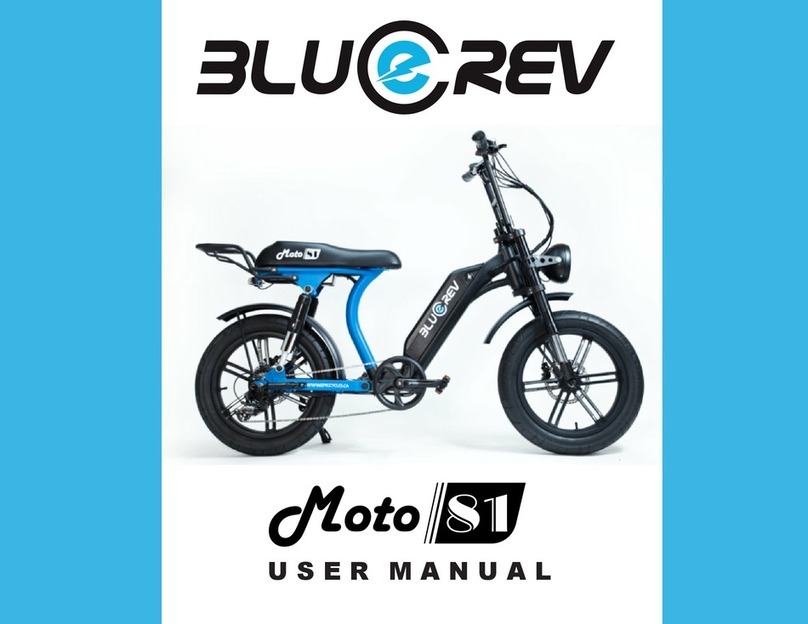
BLUEREV
BLUEREV MOTO81 user manual
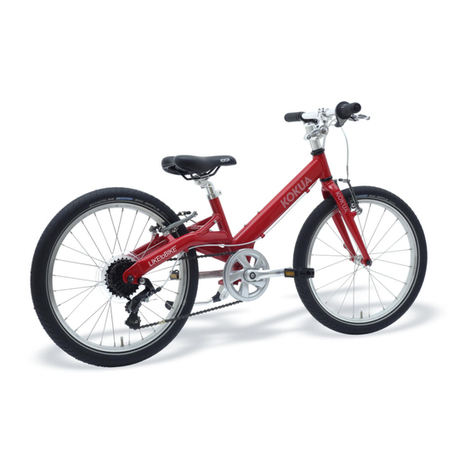
KOKUA
KOKUA LIKEtoBIKE 20 Assembly and operating instructions
